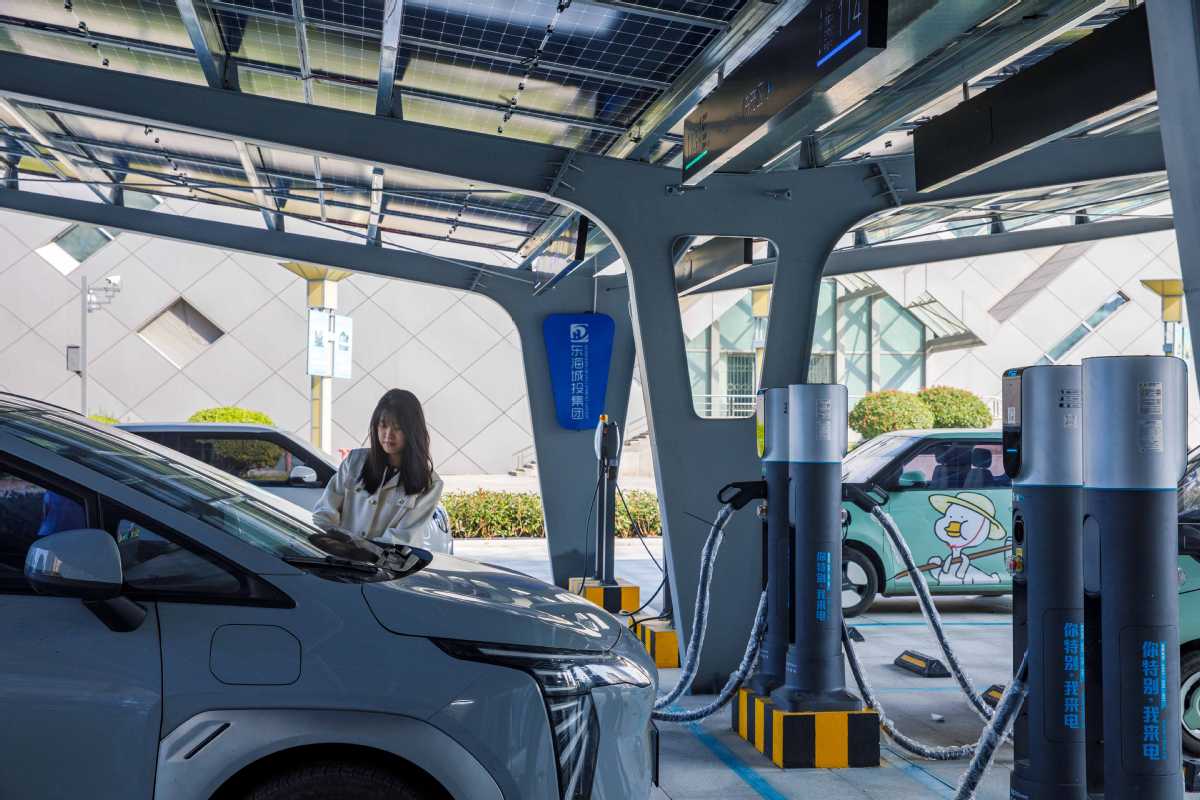
A user charges a new energy vehicle in Lianyungang, Jiangsu province, in October. CHAI JUNWEI/FOR CHINA DAILY
NANJING — Sun Tao, an environmentalist from Yangzhong, Jiangsu province, has made a conscious decision to charge his electric car at a parking lot near his home that offers green charging services.
The 180-square-meter car park, part of a local microgrid project, is equipped with photovoltaic panels and energy storage facilities. Green electricity is primarily used by nearby residents to charge electric vehicles.
"The project helps to facilitate charging new energy vehicles and reduce reliance on conventional energy, thus further reducing carbon emissions," Sun said.
China has seen explosive growth in the NEV sector in recent years. It had ranked first in the world in NEV production and sales for nine consecutive years, with the number of NEVs in use surging to 20.41 million by 2023, according to official data.
To serve the increasing number of electric cars, China has continued to expand its network of NEV charging facilities, which marked a growth of 65 percent year-on-year to reach nearly 8.6 million units by the end of 2023, said the National Energy Administration.
Jiangsu has built the country's first smart electric vehicle charging and battery-swapping demonstration zone. With about 1,300 chargers, it can reduce the average monthly waiting time for charging by nearly 50 percent through intelligent algorithms, said State Grid Jiangsu Electric Power Co Ltd.
The advancement of the NEV sector, which is instrumental in reducing vehicle emissions, exemplifies China's ongoing commitment to a green future.
In recent years, the country has made vigorous efforts in green transition, injecting fresh impetus into its economic trajectory while steadfastly pursuing its dual carbon goals of peaking carbon emissions before 2030 and achieving carbon neutrality before 2060.
These efforts are sparking the development of an array of high-tech and green sectors, which are becoming new bright spots and drivers of the world's second-largest economy.
China dominates the global NEV market with an over 60 percent share. It also supplies 50 percent of the world's wind power equipment and 80 percent of photovoltaic products.
China's exports of the tech-intensive green trio — lithium-ion batteries, photovoltaic products and NEVs — amounted to 1.06 trillion yuan ($146.5 billion) last year, a robust increase of 29.9 percent year-on-year.
The NEA said the country's total installed renewable energy capacity topped 1,516 gigawatts at the end of last year, accounting for 51.9 percent of its total installed power generation capacity and contributing to nearly 40 percent of the global installed renewable energy capacity.
This outcome is a result of years of extensive investment in green energy resources across the country, including in major coal-producing areas — the Inner Mongolia autonomous region and Shanxi province.
Inner Mongolia reported a new energy investment boom in 2023, boasting a remarkable 33 percent year-on-year growth, according to the regional energy department.
The region's installed new energy capacity increased by more than 31 GW, a record high, to 92.6 GW, accounting for 45 percent of its total installed power generation capacity.
Off the coast of Yancheng, Jiangsu, more than 100 wind turbines — part of an offshore wind power facility jointly developed by Electricite de France and a Chinese company — stand tall, collectively generating roughly 1.4 billion kilowatt-hours of electricity annually.
"China has developed into the world's largest offshore new energy market, while Europe possesses technological and experiential prowess. The prospects for cooperation between the two sides are very broad," said Erwann Debos, CEO of EDF Renewables China.
"Accelerating carbon reduction and fostering economic growth are not mutually exclusive," said Lin Weibin, an expert from the China Energy Research Society.
"As China has been adjusting its industrial and energy structures and promoting energy conservation, more green productive forces are expected to be cultivated, thus realizing a win-win situation for reducing carbon emissions and promoting economic growth," Lin said.
Source: By Xinhua News Agency, chinadaily.com, Apr. 03, 2024 [https://www.chinadaily.com.cn/a/202404/03/WS660cb406a31082fc043c02f0.html]

